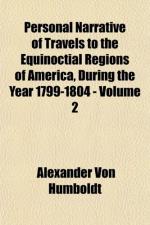|
This section contains 598 words (approx. 2 pages at 300 words per page) |

|
 Alexander von Humboldt.
Alexander von Humboldt.
German Explorer and Scientist 1769-1859
Alexander von Humboldt was the greatest explorer-scientist of the eighteenth and early nineteenth centuries. Humboldt's contributions to science were remarkably diverse. He was the first person to map areas of equal air temperature and pressure, a technique now used in every weather forecast around the world. By measuring the magnetism of rocks in the Alps, he found that Earth's magnetic field reverses its polarity. This fundamental discovery allowed geologists in the twentieth century to prove the theory of continental drift. Humboldt also developed the idea of seismic waves that travel through Earth's surface after an earthquake. In physics, he conducted more than four thousand experiments on electricity and magnetism. Perhaps his most important research, however, concerned the distribution and environmental relationships of plants.
Humboldt's interest in botany developed early on. While a teenager he spent many...
|
This section contains 598 words (approx. 2 pages at 300 words per page) |

|


